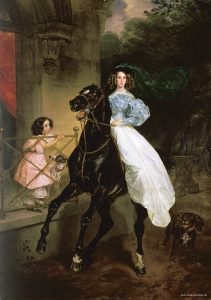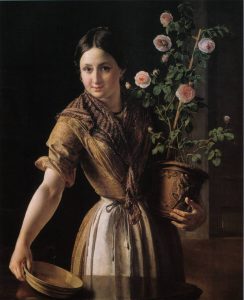The Russian painters and their styles exemplify the struggle we’ve discussed throughout the course to establish a unique Russian identity, and the confusion and idealistic and stylistic disagreement between prominent artists. Alexander Ivanov still hung onto the tradition of Neoclassicism. Rubens and Van Dyck, the “old masters”, were held up as ideals (with comparisons to Karl Bruillov’s and Orest Kiprensky’s works.) Many of the artists studied traveled abroad to learn and improve, often to Italy. This follows the tradition of Westernization since Peter’s time, the borrowing of Western Europe’s styles and ideas, and perhaps a sense of inferiority or insecurity about Russia’s own culture.
It also shows a slight increase in social mobility; Vasily Tropinin and Orest Kiprensky were both born serfs, but Kiprensky was freed and educated, while Tropinin pursued education on his own, attending drawing classes in secret. Alexei Venetsianov was from a merchant family, not a serf, chose to depict peasant life, and taught paintings to serfs and people from poor families. Although he did not always meet with approval, his choices still demonstrate perhaps a trend of more people taking note of the serfs’ lives and struggles, and trying to give them a chance to have better lives.


